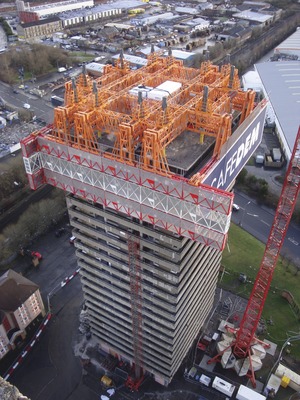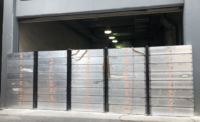

When seen from above, it looks like a giant orange spider perched on top of a skyscraper. But Italy-based Despe's TopDownWay demolition system is a method that takes down towers faster—and sometimes cheaper—than regular demolition techniques.
"You normally have two options to demolish buildings: implosion or fully encase the building in scaffolding," says Stefano Panseri, CEO of Despe. "We have invented a self-descending demolition system that can support itself on the existing columns of the building."
TopDownWay consists of a modular steel platform assembled on top of the tower, with hydraulic supports deployed on the existing columns. This setup allows the building to support the load of the modular frame, including its three levels of retractable walkways and framework. "It's not like scaffolding, which moves and wobbles," says Roberto Panseri, managing director at Despe. "It's a solid, three-story frame that you can work off of."
Once a three-story section is finished, the support jacks are hydraulically lowered as each column is demolished. The entire "cocoon" assembly then descends three floors, and the next phase of demolition can begin. Metal netting and safety rails protect works and contain debris. Foggers can be deployed along the frame for dust control, and extra containment can be set up for asbestos abatement.
By limiting demolition activities to the upper floors, setup times are faster than scaffolding. "We can have the system fully set up in only 20 days to demolish a 1,000-square-m, 30-story building." says Stefano Panseri. "It would take months to assemble the scaffolding for that."
Site limitations are also driving use of TopDownWay. When looking to take down the Bluevale and Whitevale residential towers in Glasgow, Scotland, Dundee-based demolition contractor Safedem saw that implosion was not an option. With active buildings within a few feet of the tower, they chose TopDownWay to limit activity at street level.
The system has not yet been employed in North America, but it has been used on several towers across Europe. While the expense of the Despe system does not make sense on a smaller building, Stefano Panseri says it is a much more attractive option for removing skyscrapers in dense cities. "Right now, we [are] competitive on cost for buildings over 75 m to 80 m in height. At that point, the scaffolding costs become too onerous, and there are all kinds of safety issues and related costs."
TopDownWay may also help owners who would otherwise gut and renovate old skyscrapers. "It gives them that choice," says Stefano. "Many old tall buildings could be replaced with better structures—the cost is now workable."




Post a comment to this article
Report Abusive Comment